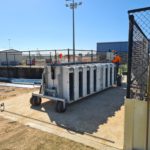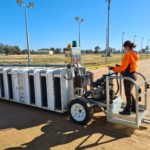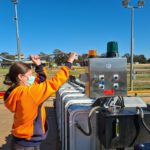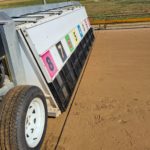Greyhound Racing Victoria’s continual pursuit of safer racing across Victoria relies on a range of interrelated disciplines.
These encompass continued safe and improved track design, quality track maintenance and education and preparation of greyhounds.
To achieve the safest possible outcome, all of these must work concurrently to achieve the overall objective of reducing racing injuries as part of the GRV Safe Racing Program and commitment backed by a $10m investment across the state.
One example of this integration is Shepparton Greyhound Racing Club.
Over a three-year period until 2019, Shepparton had racing injury statistics in the mid-40s per 1000 starters.
However, infrastructure and other interventions from 2018 to 2019 has seen this level reduced to 35 per 1000, making Shepparton one of the safest tracks in the state.
KEY STAT:
Shepparton had racing injury statistics in the mid-40s per 1000 starters. This has reduced to 35 per 1000, making Shepparton one of the safest tracks in the state.
Among these improvements were an increase in track camber to reduce race turning injuries, improved track harrowing, increased track monitoring and water management and the introduction of roll-on starting boxes for the 385m distance (see image above).
The introduction of these boxes was based on modelling undertaken at other tracks by the University of Technology, Sydney, and is designed to reduce initial start clustering thereby reducing track injuries.
While the Shepparton GRC has worked closely with GRV infrastructure in relation to the physical improvements to the track, club manager, Carl McGrath, believes other measures undertaken by the club have also impacted the reduction of race injuries. These include the Shepparton track staff’s willingness to adapt and respond to suggested changes.
Among the non-track changes is the introduction of a resident veterinary clinic at the track for up to three days a week.
“I believe free trials have played a role in greyhound safety and welfare by providing participants with a benefit – both to them and their animal – by encouraging them to trial before nominating” – CARL McGRATH
Separate from the GRV race day veterinary oversight, and dealing exclusively with greyhounds, the Shepparton Greyhound Veterinary Clinic provides the local industry with a range of regular veterinary services as well as desexing services.
“Apart from providing basic veterinary services the clinic already offers dental work, x-rays and some surgeries and we see it as an additional participant service which greatly assists in animal welfare,” Carl said.
“Because of this we have had a lot of positive comments from participants indicating that the dogs are racing more often and not suffering as many injuries.”
He also believes that the introduction of free trialling has had a significant impact on reducing racing injuries.
Recent welfare initiatives at Shepparton
– Increase in track camber to reduce injuries on race turns
– Improved track harrowing
– Increased track monitoring and water management
– Roll-on starting boxes for the 385m distance
– Resident vet on-site three days a week
– Free trials which encourages better preparation of greyhounds for racing
“With the support of GRV we introduced free trialling for a six-month period with a view that it would ensure local trainers and breeders did not minimise race preparation,” he said.
“It was so successful that it was extended for a further three months before GRV introduced it at other venues across the state.
“I believe free trials have played a role in greyhound safety and welfare by providing participants with a benefit – both to them and their animal – by encouraging them to trial before nominating.”
So, combined with Shepparton’s track team and GRV’s racing team, improvement ideas are continually tested and implemented which ensures Shepparton ticks all the boxes in the continuing quest for safer racing.
* This article was written by Tony Homfray






